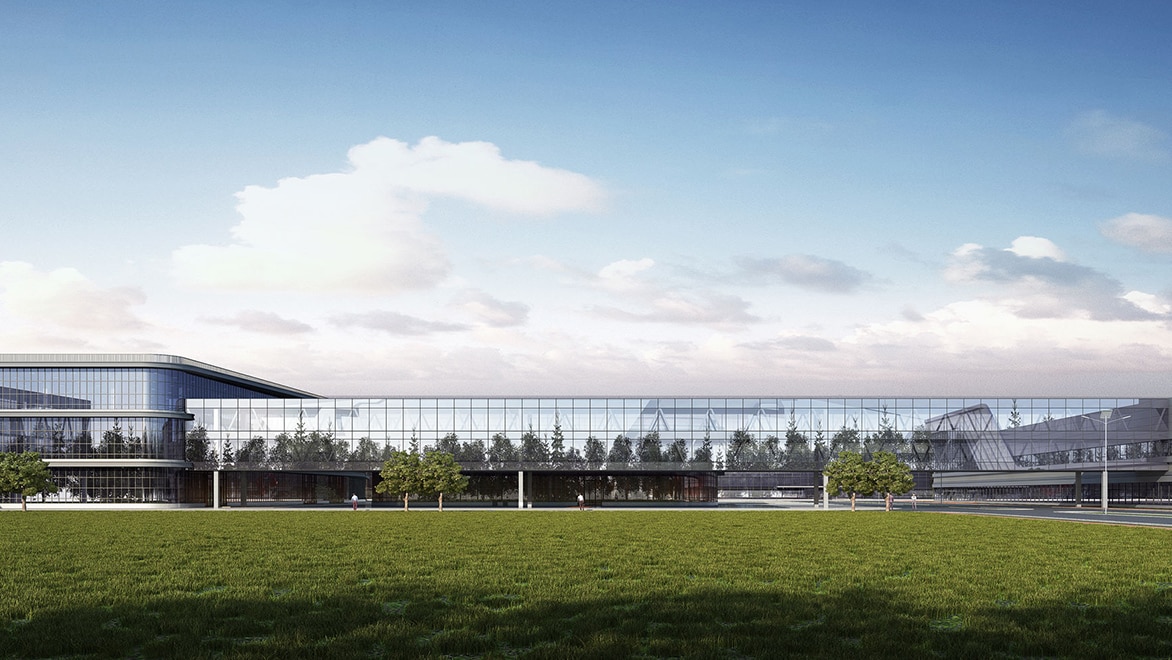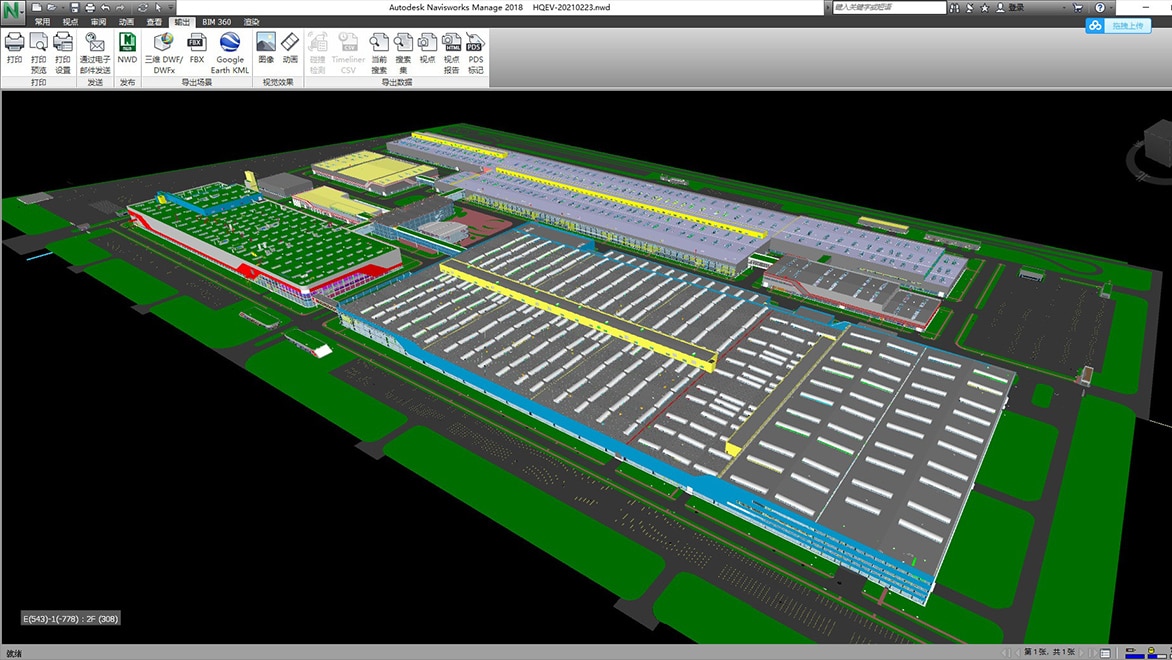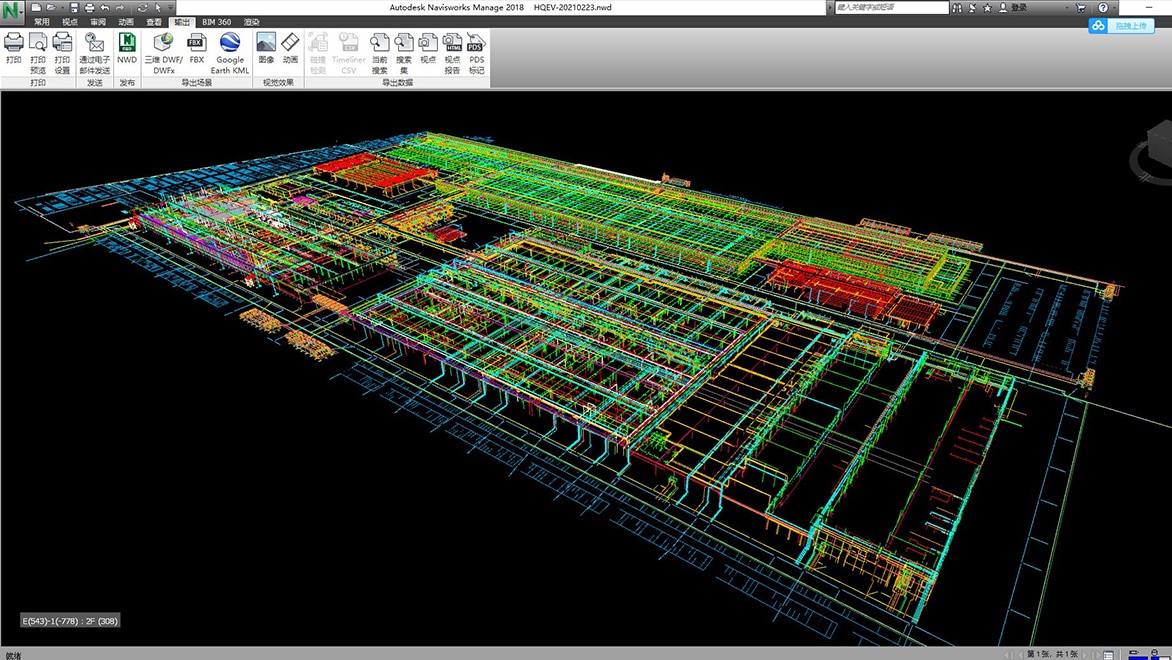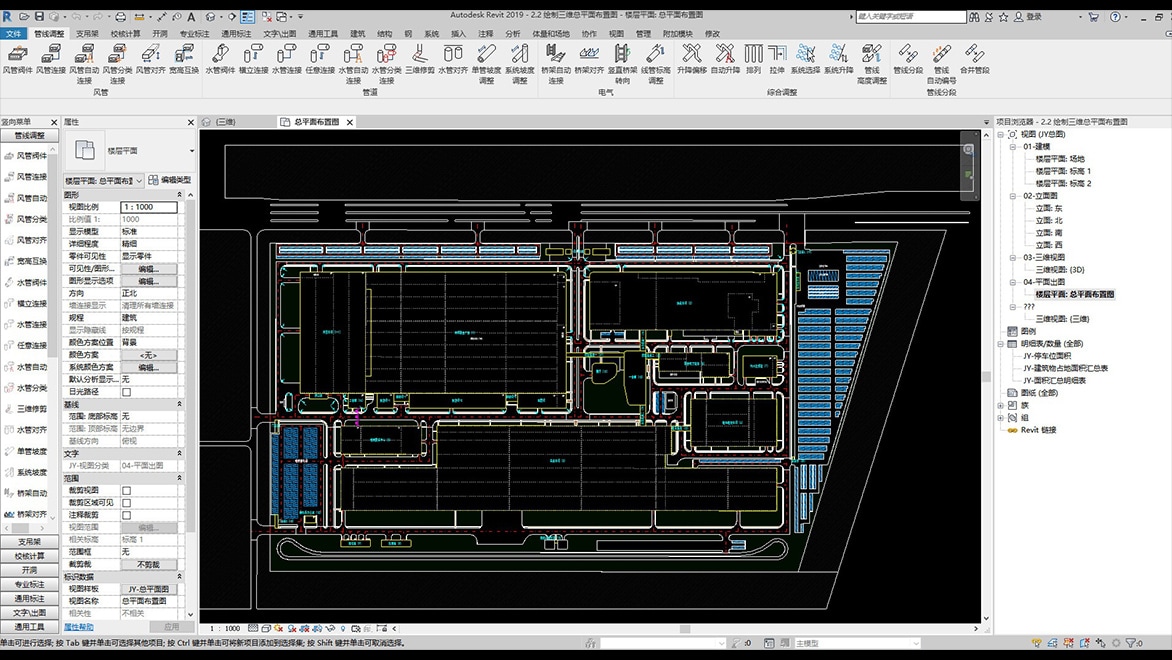IX Institute
Digital Empowerment and Integrated Innovation
Plant design
Share this story
Autodesk’s Integrated Factory Model solution helps FAW Hongqi new energy vehicle factory accelerate its BIM transformation and application
__________________________
MMI Planning & Engineering Institute IX Co., Ltd. (“IX Institute”) completed its BIM transformation with the help of Autodesk solutions. Currently, the IX Institute primarily utilizes AutoCAD® and Civil 3D® in the project planning phase to design the roads and pipelines within the factory area. During the project design phase, Autodesk Revit® is mainly used for forward design, while Autodesk Navisworks® is used for model integration and collision check. In the construction and delivery phase, Autodesk ReCap® is deployed for point cloud model processing, and Autodesk 3ds Max® is leveraged for model rendering to produce animations for construction and delivery purposes. At the same time, IX Institute adopts Autodesk's Integrated Factory Model solution to integrate production line BIM with building BIM, so that all disciplines of factory projects can be effectively integrated into the same space for collaborative design.
Founded in 1958, the MMI Planning & Engineering Institute IX Co., Ltd. (“IX Institute”) is a Grade A design and research institute specializing in the planning, design, and construction of automobile factories in China. It holds the titles of a national high-tech enterprise and state-level industrial design center, and is widely acclaimed as the "cradle of automobile factory design in China."
IX Institute is highly market-oriented and innovation-led by continuously promoting business transformation and upgrading; and is committed to providing customers with whole-process technical services in scientific research, engineering consulting and design, engineering project management and general contracting, etc. IX Institute has been ranked among the top 100 national survey and design powerhouses, and the top 100 national general contracting project management powerhouses for six consecutive years.
IX Institute has 725 professional and technical personnel, including four national engineering survey and design masters, five provincial design masters, 13 experts enjoying the government subsidies of the State Council, 13 top-notch talents with outstanding innovation contributions in Jilin Province and Changchun City, and 223 experts at or above the provincial and ministerial level. Its customers are mainly medium and large-sized automobile OEMs and automobile parts enterprises, with projects distributed across different regions throughout China. IX Institute's commercial vehicle customers include FAW Jiefang, Shaanxi Automobile, Xiamen Golden Dragon, FAW Dalian Bus Factory; in terms of passenger cars, FAW-Volkswagen, Tianjin Toyota, Volvo, Geely, Great Wall are in the customer list.

Soldering station corridor
© MMI Planning & Engineering Institute IX Co., Ltd.
Digital evolution leads to brilliant achievements
The attainment of these brilliant achievements is rooted in the repeated major decisions made by IX Institute, with the adoption of BIM being a significant transformational step. As for why IX Institute decided to embrace BIM transformation, Li Feng, Senior R&D Engineer at IX Institute, believes that the only constant in manufacturing is change. The advancements in technology have resulted in the ever-increasing complexity of factory techniques, prompting automotive industry to adopt minor revisions every three years and major changes every five years as standard practice. Especially in recent years, the continuous emergence of new technologies and an increase in small-batch, personalized, and flexible production have led to more frequent changes in production lines. Therefore, traditional 2D design no longer meets design requirements. The adoption of digitization is necessary to fully address the challenges encountered throughout the manufacturing process.
“In factory projects, meeting production requirements is essential, and production line equipment plays a crucial role in this regard. Therefore, it is necessary to integrate the BIM of production lines with that of buildings, which is referred to as Autodesk’s Integrated Factory Model. Also, the BIM model of a factory can provide significant value throughout its lifecycle, including design, construction, and operation and maintenance. Additionally, it can serve as a data archive for future technology upgrades and transformations of the factory. In the past, there were severe data silos across disciplines, and the quality of the data was also suboptimal. Nowadays, with the aid of Autodesk solutions, various disciplines of factory projects can be effectively integrated into the same space for collaborative design.”
— Li Feng
Senior R&D Engineer, MMI Planning & Engineering Institute IX Co., Ltd.
The digital evolution journey of IX Institute has gone through three stages. Starting from 2006, they attempted to apply 3D modeling to express various design schemes. The focus was to use simple model representations to facilitate effective communication with owners. Then in around 2010, IX Institute launched its comprehensive transformation towards digitization, where project teams were assigned to conduct 3D designs in each aspect of building equipment. Additionally, this stage placed more emphasis on delivering the final results successfully. From 2018, IX Institute's digital transformation has entered an integrated innovation stage that is focused on improving and optimizing designs while reducing costs, ultimately leading to the overall digitization of the entire process. IX Institute attaches great importance to digital technology, and as part of their overarching strategic plan, they have designated becoming a leader in digital application in the industry as one of the company's strategic objectives.
The development of leading digital application is also a result of both internal and external driving forces at IX Institute. IX Institute satisfies various market demands from clients, such as ensuring project quality and construction cycle, improving communication efficiency, identifying project progress issues and promptly solving them in a closed-loop manner, generating proprietary digital assets, and providing data support for factory operation and maintenance needs. All these factors collectively constitute the external driving forces of digital transformation at IX Institute. With regard to internal driving forces, IX Institute achieves internal improvement and cost reduction by comprehensively enhancing design quality, reducing design changes due to drawing issues, decreasing construction and procurement costs, significantly improving design techniques, expanding business, strengthening overall process control for engineering projects, and rapidly increasing core competitiveness.

© MMI Planning & Engineering Institute IX Co., Ltd.
Autodesk solutions help IX Institute complete its BIM transformation
The main approach for IX Institute's BIM transformation is to utilize solutions from Autodesk. Currently, IX Institute primarily utilizes AutoCAD and Civil 3D in the project planning phase to design the roads and pipelines within the factory area. During the subsequent project design phase, Revit is mainly used for forward design, while Navisworks is used for model integration and collision check. In the construction and delivery phase, ReCap is deployed for point cloud model processing, and 3ds Max is leveraged for model rendering to produce animations for construction and delivery purposes.
Located in Changchun Automobile Industry Technology Development Zone, Hongqi New Energy Vehicle Factory project is one of the most representative projects of MMI Planning & Engineering Institute IX Co., Ltd., with a total area of 756,000 square meters and a construction area of about 435,000 square meters. The project comprises a punching and welding plant, painting workshop, final assembly workshop, battery & electric drive workshop, sewage treatment station, combined power plant, logistics distribution center, etc.
Its total investment reaches 8 billion RMB, which is a key project of FAW Hongqi's development strategy, and also an important project to support the regional economic development of Changchun City.
The project encountered unprecedented challenges as soon as it was planned. According to Li Feng, a Senior R&D Engineer of IX Institute, this project exceeds previous benchmarks in terms of delivery quality and timeline; moreover, the owner clearly required IX Institute to build a world-class, domestically leading, intelligent, flexible, and green digital factory, and a "New Noble" modern intelligent factory that can meet Hongqi’s production needs. This requires IX Institute to deliver both digital factory and physical factory. With the aid of Autodesk's Integrated Factory Model solution, IX Institute was able to break down the entire lifecycle of the factory into five stages: planning, design, validation, construction, and operation. BIM technology is applied at each stage, which can provide data models for the next stage; meanwhile, the linkage between the site data and the design data could fully support the construction and operation of the digital twin factory.

© MMI Planning & Engineering Institute IX Co., Ltd.
Navisworks is used to resolve collision conflicts and interferences
Hongqi new energy vehicle factory project encountered numerous difficulties during its completion, with interdisciplinary collaboration being the most challenging and complex aspect. According to Li Feng, a typical project factory requires the participation of 20 to 30 specialized disciplines. The design and supervision of construction can be very challenging, along with the involvement of dozens of equipment suppliers and construction parties. The integration of various mechanical software formats with BIM models can face a range of issues, where any changes on one side would require an update of all integrated models, which is time-consuming and prone to errors.
“We completed the integration of the entire building model and equipment model by using the Autodesk platform, which is featured by Navisworks and Revit. Online collaboration was achieved by various disciplines, inside and outside, through the collaborative platform. The collaborative platform provided a process-based and standardized whole-process management system to ensure the unified integration of project teams and information. With this platform, we reduced the design errors and omissions by more than 50%, successfully delivering the virtual and physical factory to the owner, realizing the digital operation & maintenance of the factory.”
— Li Feng
Senior R&D Engineer, MMI Planning & Engineering Institute IX Co., Ltd.
Finally, IX Institute utilized Navisworks for model integration and collision check. Navisworks software is not only compatible with various 3D software used by IX Institute, but also can access model formats from owners, constructors, and equipment suppliers. Additionally, it can ensure model lightweighting while maintaining a high level of performance, Li Feng, a Senior R&D Engineer of IX Institute, said.
Interference issues during the construction stage will directly affect the delivery schedule and construction cost of the entire project. For example, in a painting workshop, some interference issues include collisions between fire exhaust pipes and spray booths, the occupied space interference of rainwater pipes and process equipment passageways, interference between fire exhaust pipes and mechanized elevators, piping above jet platforms, as well as ensuring adequate spacing for maintenance purposes. Navisworks proved to be extremely effective in helping IX Institute resolve interference issues in their project. Li Feng said that more than 2,000 collision problems was solved with Navisworks during the design phase; at the same time, they applied Revit for forward design, and for solving some complex foundation collisions.
The utilization of this solution is particularly helpful in general contracting projects, where it can greatly assist in reducing costly delays resulting from repeated construction and ultimately promote significant savings. In the project, Li Feng and his colleagues also used Navisworks software for collision adjustment process optimization. Initially, the entire cycle was about five days; after the optimization, the review cycle was completed in only 2-3 days. Li Feng emphasized, “We completed the integration of the entire building model and equipment model by using the Autodesk platform, which is featured by Navisworks and Revit. Online collaboration was achieved by various disciplines, inside and outside, through the collaborative platform. The collaborative platform provided a process-based and standardized whole-process management system to ensure the unified integration of project teams and information. With this platform, we reduced the design errors and omissions by more than 50%, successfully delivering the virtual and physical factory to the owner, realizing the digital operation & maintenance of the factory.”

© MMI Planning & Engineering Institute IX Co., Ltd.
Application of BIM model in Hongqi new energy vehicle factory project
In terms of the application of BIM models, the foremost scenario is composite computing. HVAC specialists calculate the energy load in a space by setting up such data as geolocation, environment, energy consumption, construction materials, construction type, and so on, through which they can help designers choose the equipment type. In addition, lighting simulations were also achieved in Hongqi project. By simulating the lighting environment of the site, the electrical specialists can no longer rely on traditional data and truly combine the design and construction site; they can comprehensively consider the influence of the space environment on the lighting effect at the very beginning of the design, so as to effectively change the parameters and arrangement of the lamps, making the lighting design more accurate and more energy-saving.
The welding smoke hazard in the welding workshop was very serious in the past, but now IX Institute improves the scheme with Revit software by using analysis data to optimize the layout of air supply and exhaust outlets, guiding the selection of welding smoke treatment equipment, and reducing the hazard of welding smoke. Finally, the factory meets the requirements of occupational health.
In the civil construction, laser was used to accurately scan key parts, then the point cloud data processed by ReCap is compared with the design model, so that the location of the discrepancy can be found in the first place and corrected in time. With this technology, they don’t have to modify it as the construction goes deeper, or avoid significant workload after modification. To avoid construction deviations in the utility pipeline, the scanned 3D model will be compared with the design model.
With this advantage, they can analyze whether the model will impact the subsequent construction: if yes, they will notify the construction team for rectification in time; if no, the design department will adjust the design model, which will greatly improve the construction efficiency.
Li Feng, Senior R&D Engineer of the MMI Planning & Engineering Institute IX Co., Ltd., finally emphasized: "The factory projects are intended for production and the production line equipment is a very important part of a factory. Therefore, we have to integrate production line BIM with building BIM, i.e., the Autodesk’s Integrated Factory Model. Also, the BIM model of a factory can provide significant value throughout its lifecycle, including design, construction, and operation and maintenance. Additionally, it can serve as a data archive for future technology upgrades and transformations of the factory. In the past, there were severe data silos across disciplines, and the quality of the data was also suboptimal. Nowadays, with the aid of Autodesk solutions, various disciplines of factory projects can be effectively integrated into the same space for collaborative design. Next, we will also connect it with the real IoT to improve the efficiency of factory operation & maintenance.
In the future, the MMI Planning & Engineering Institute IX Co., Ltd. will continue to push digital transformation, and provide owners with a more efficient and perfect factory model through Digital for Business and Business for Digital ideology.”
See related products
-
CAM software for high-speed and 5-axis machining—available as Standard, Premium, Ultimate
-
2D and 3D CAD tools, with enhanced insights, AI-automations, and collaboration features. Subscription includes AutoCAD on desktop, web, mobile, and seven specialized toolsets.
-
-
Plan, design, construct, and manage buildings with powerful tools for Building Information Modeling.
-
Navisworks Manage, Navisworks Simulate software and the Navisworks Freedom 3D viewer for 5D analysis, design simulation, and project review.
-
-
Learn more













